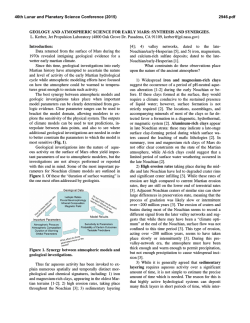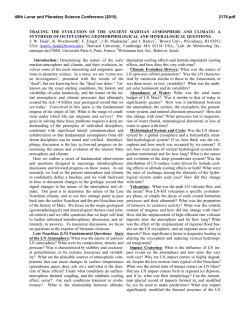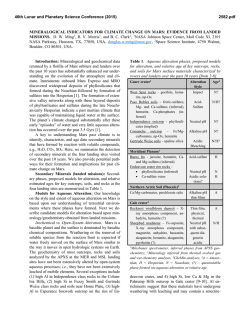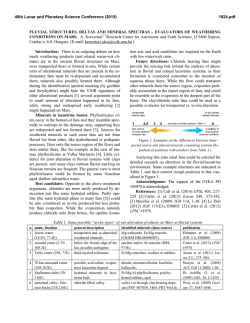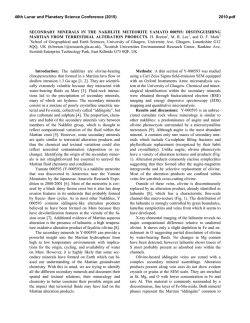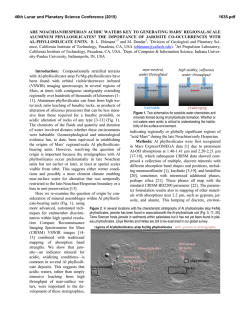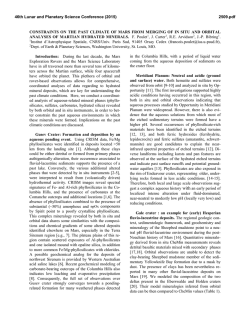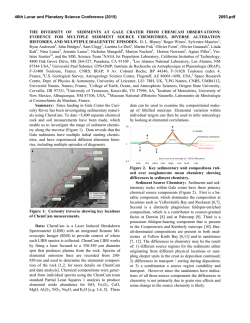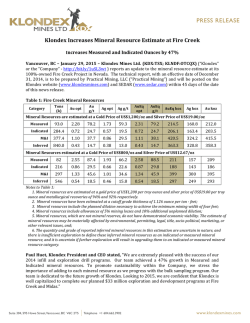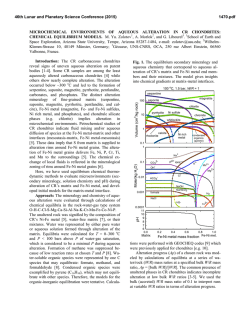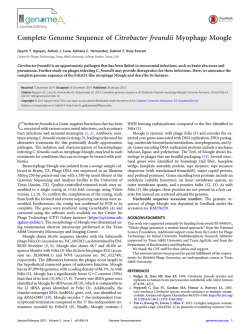
MINERALOGIC CONSTRAINTS ON LATE NOACHIAN CLIMATE
46th Lunar and Planetary Science Conference (2015) 2362.pdf MINERALOGIC CONSTRAINTS ON LATE NOACHIAN CLIMATE. J. F. Mustard1, 1Department of Earth, Environmental and Planetary Science, Box 1846, Brown University, Providence, RI 02912, [email protected]. Introduction: The mineralogy of the Martian surface and crust is a function of fundamental igneous processes in the case of igneous rocks and of the aqueous chemistry in the case of hydrated minerals [e.g. 1]. Depending on the degree of interaction between the atmosphere and the hydrosphere, the atmosphere can have a strong influence on the minerals and mineral assemblages formed. In this contribution I outline some of the constraints Mars mineralogy detected from orbit has on Late Noachian Climate. There are two endmember hypotheses for the dominant environment for the formation of hydrated silicates on Mars: (1) near surface environments such as soils with a strong coupling to an active hydrosphere [2] and (2) shallow crustal environments with low temperature hydrothermal systems driven by geothermal heat or impact heating [3]. Due to the dominance of impact cratering and the lack of plate tectonics for recycling crust and refreshing the surface the upper several kilometers of the martan crust is like the moon though largely basaltic to mafic in composition and fragmented and brecciated by impact with variable but think cover from Aeolian processes, volcanism and air fall deposits [4]. In general well-preserved and exposed environments of formation for aqueous silicates are rare and often obscured by cover from later air fall or sedimentary deposits or dust cover. While there are many environments between these two endmembers where alteration may occur, there are five predominant processes I consider here: pedogenesis, fluvial erosion and deposition, hydrothermal alteration, diagenesis and metamorphism, and magmatic precipitation or deuteric alteration. Hydrous minerals are largely confined to terrains of Noachian age [5] and it has been proposed that most formed prior to the middle Noachian [2] thus it is important to consider alteration processes, their environments, and relationship to Noachian climates. Clay formation on Earth [6] provides a fundamental guide to the mineral assemblages expected for alteration minerals formed from basaltic substrates. Near-surface and surface pedogenic environments which involve an active hydrosphere with leaching may be expected to have Fe/Mg and Al smectite clay with kaolinite in sites with appropriate water/rock ratios and fluid chemistry. Where water/rock ratios are high, soil-like deposits near the surface will have vertically stratified structure of Al-bearing phyllosilicates over Fe/Mg phyllosilicates and accompanying minerals of carbonate and silica and/or poorly crystalline phases like palagonite and imogolite [7]. Because of the very strong coupling between the atmosphere, hydrosphere, and environment of alteration these environments may provide the strongest constraints on Noachian climate. At the other end of the spectrum, mineral assemblages produced in the crust due to magmatic precipitation/deuteric alteration [8] provide the least constraints on Late Noachian climates because the volatile reservoir responsible for the aqueous alteration is effectively sequestered from the atmosphere. Magmatic precipitation may, however, have a strong effect on the atmosphere through volatile release (e.g. SO2, H2O) during degassing of erupting magmas. In fact the release of massive amounts of SO2 associated with the huge eruptions that formed the ridged plains in the northern hemisphere has been hypothesized to be a key factor in the dominance of hydrated sulfate deposits of Late Noachian/Early Hesperian age [5]. Key minerals expected to be present from this form of aqueous mineral formation are Fe/Mg smectite, celadonite with minor silica. Many regions of the exposed Noachian terrain have valley networks of varying drainage density and maturity [9]. While there is a diversity of ideas of the precise processes involved, most researchers acknowledge that precipitation and/or hydrothermal recharge is required to enable enough flow to carve the networks. Valley networks and open basin lakes are signature morphologies of at least brief periods of sustained fluvial activity [10] and deltaic and other associated deposits have been considered prime candidates to search signs of neoformed (e.g. precipitated) minerals (which would provide strong constraints on the atmospheric composition) [11]. However the mineral phases detected in the lacustrine deposits thus far are mostly identical to those in the watersheds feeding the open basin lake sedimentary deposits [e.g. 12] and in fact the mineral assemblages in the deltas associated with Jezero Crater open basin lake are proportional to the aerial exposure of aqueous mineral phases in the watershed [13]. This is strong evidence for the transport of pre-existing altered minerals rather than neoformation of phyllosilicates in lacustrine settings. Hydrothermal alteration may occur under open (e.g. in contact with the atmosphere) or closed system conditions. Under open system conditions, there is a strong possibility that the aqueous minerals formed contain a direct signal of the composition of the at- 46th Lunar and Planetary Science Conference (2015) mosphere at the time of mineral formation. Detailed analysis of the Nakhla Martian meteorites shows strong evidence for Martian hydrothermal alteration in a near surface setting [14, 15]. The source of heat is hypothesized to be a small to modest sized impact and the fluid chemistry strongly influenced by CO2 and H2O ice proximal to the impact. With increased analysis of remotely sensed data and characterization of mineral assemblages of Noachian-aged outcrops there is a promise to derive stronger constraints on Noachian climates at regional and global scales as [14, 15] did for the Nahkla source region. The absence of extensive carbonate deposits on Mars has been interpreted to be evidence for early Martian climates with low partial pressure of CO2 [16] while climate models sufficient to sustain liquid water during Late Noachian valley network formation require either require thick CO2 atmospheres or enriched in SO2, CH4 and other strong greenhouse gasses [17]. Geochemical conditions on early Mars conducive to the currently observed mineral assemblages dominated by Fe/Mg phyllosilicates, lack of extensive carbonates, and highly oxidizing conditions require weakly acidic to alkaline aqueous conditions [18]. These provide strong constraints on Noachian climate if there was a strong coupling between aqueous environments and the atmosphere. This is certainly the case for many of the notable deposits of hydrous minerals on Mars [2, 3, 5]. Perhaps one of the strongest constraints on Noachian climates is the relative lack of sulfates in Noachian-aged outcrops compared to Hesperian-age surfaces. Some of the mineral assemblages in sulfatebearing deposits contain jarosite imply a low pH while the predominance of Fe/Mg phyllosilicates in Noachian-aged terrains generally requires a pH greater than 4 and more likely 5 [18, 19]. More detail characterization of sulfate- and chloride-bearing deposits and relationship to phyllosilicate outcrops, and their stratigraphic ages will also be required to constrain the late Noachian and Early Hesperian climates. References: [1] Ehlmann, B. L. et al. (2013) Space Sci. Rev. 174:329-364, doi 10.1007/s/11214-012-9930-0. [2] Carter, J. et al., (2013) JGR, 118, 831-858 doi:10.1029/2012JE004145. [3] Ehlmann, B. L. et al. (2011) Nature 479, 53–60. doi:10.1038/nature10582 [4] Carr, M. H. and J. W. Head (2010) EPSL 294 185– 203 doi:10.1016/j.epsl.2009.06.042. [5] Bibring, J-P., et al., Science 312, 400–404. [6] Meunier, A. (2005) Clays (Springer, Berlin,). [7] Schiffman, P. et al., (2000) Geochem. Geophys. Geosyst. 1, doi: 2000GC000068. [8] Meunier, A., et al., (2012) Nature Geoscience, Vol. 5 Pages: 739-743 2362.pdf DOI:10.1038/NGEO1572. [9] Carr, M. H (1996) The Surface of Mars. Cambridge University Press. 307 pp. [10] Fassett, C.I., Head, J.W. (2008) Valley networkfed, open-basin lakes on Mars: distribution and implications for Noachian surface and subsurface hydrology. Icarus 198, 37–56. doi:10.1016/j.icarus.2008. 06.016 [11] Poulet, F., et al. (2009) Astrobiology Vol. 9, 257-267 DOI: 10.1089/ast.2009.0335 [12] Ehlmann, B. L. et al. (2008) Nat. Geosci. 1, 355–358 (2008b). doi:10.1038/ngeo207 [13] Goudge,T. A. et al. (2014) LPS XLV Abstract #1164 [14] Hicks, L. J., et al. (2014) GCA 316 194-210 doi:10.1016/j.gca.2014. 04.010 [15] Bridges, J. C. and S.P. Schwenzer (2012) EPSL 359–360 pp. 117–123 [16] Barbash, S., et al., (2007) Science, V. 315, 501-503. [17] Halevy, I. and J. W. Head, (2014) Nature Geoscience Vol 7 DOI: 10.1038/ NGEO2293 [18] Chevrier, V. et al. (2007) Nature v. 448 doi:10.1038/nature05961 [19] Berger, G. et al. (2009) Am. Mineral. 94, 1279–1282
© Copyright 2026
